Exploring Professional Development Opportunities in Organizations
VerifiedAdded on 2020/04/15
|20
|3359
|33
AI Summary
The assignment delves into creating opportunities for professional growth through targeted training sessions to improve skills, knowledge, and expertise. It emphasizes the necessity of identifying areas where employees may lack strengths and providing appropriate training to bolster their capabilities. The plan outlines essential skills required for gaining a competitive edge in business, such as value addition, critical thinking, leadership, and effective communication. Furthermore, it highlights the importance of participating in professional networks to manage communications better, underpin skills, and enhance professionalism. A timeline is established over four years to achieve these development opportunities, allowing staff to acquire new skills, engage in networking, and facilitate overall professional growth.
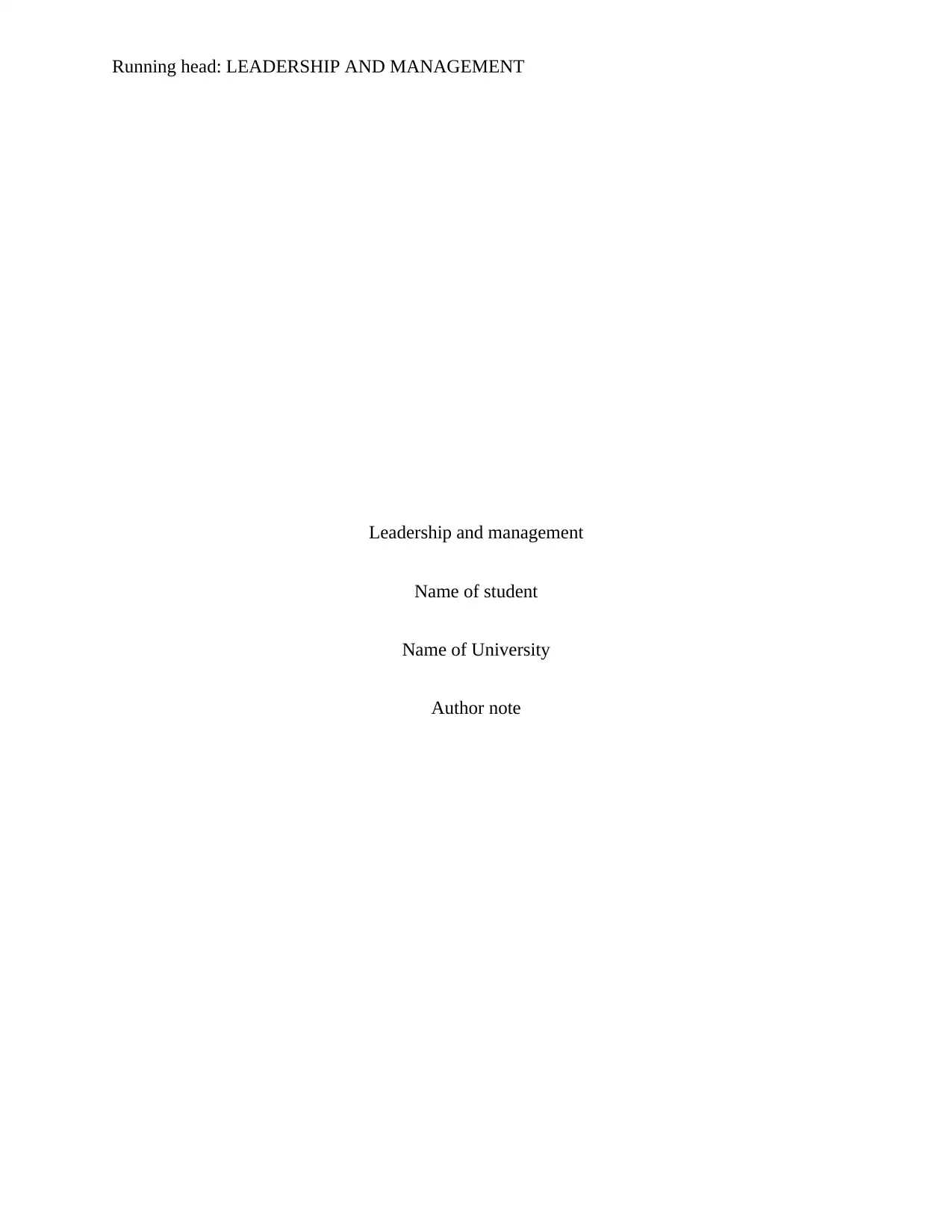
Running head: LEADERSHIP AND MANAGEMENT
Leadership and management
Name of student
Name of University
Author note
Leadership and management
Name of student
Name of University
Author note
Paraphrase This Document
Need a fresh take? Get an instant paraphrase of this document with our AI Paraphraser
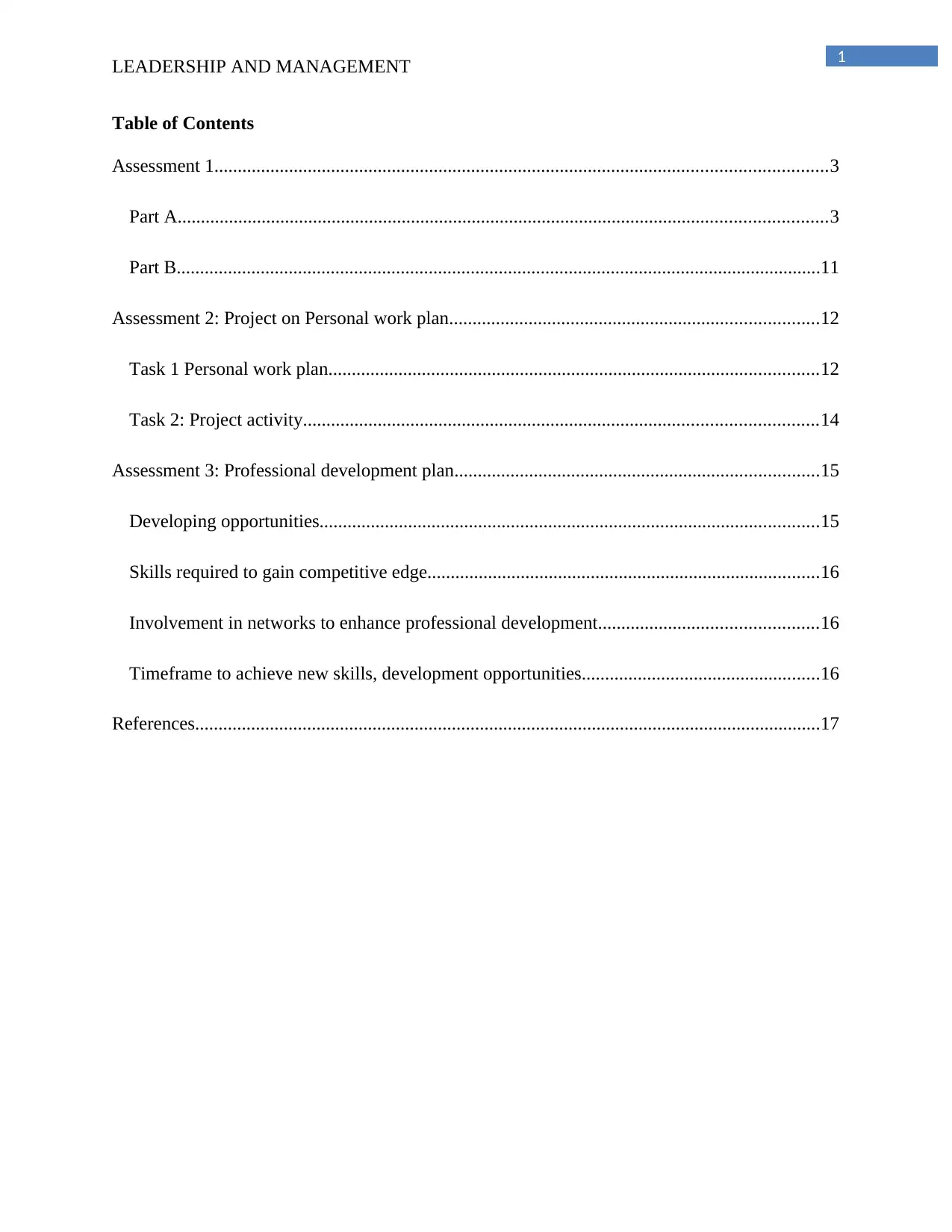
1
LEADERSHIP AND MANAGEMENT
Table of Contents
Assessment 1...................................................................................................................................3
Part A...........................................................................................................................................3
Part B..........................................................................................................................................11
Assessment 2: Project on Personal work plan...............................................................................12
Task 1 Personal work plan.........................................................................................................12
Task 2: Project activity..............................................................................................................14
Assessment 3: Professional development plan..............................................................................15
Developing opportunities...........................................................................................................15
Skills required to gain competitive edge....................................................................................16
Involvement in networks to enhance professional development...............................................16
Timeframe to achieve new skills, development opportunities...................................................16
References......................................................................................................................................17
LEADERSHIP AND MANAGEMENT
Table of Contents
Assessment 1...................................................................................................................................3
Part A...........................................................................................................................................3
Part B..........................................................................................................................................11
Assessment 2: Project on Personal work plan...............................................................................12
Task 1 Personal work plan.........................................................................................................12
Task 2: Project activity..............................................................................................................14
Assessment 3: Professional development plan..............................................................................15
Developing opportunities...........................................................................................................15
Skills required to gain competitive edge....................................................................................16
Involvement in networks to enhance professional development...............................................16
Timeframe to achieve new skills, development opportunities...................................................16
References......................................................................................................................................17
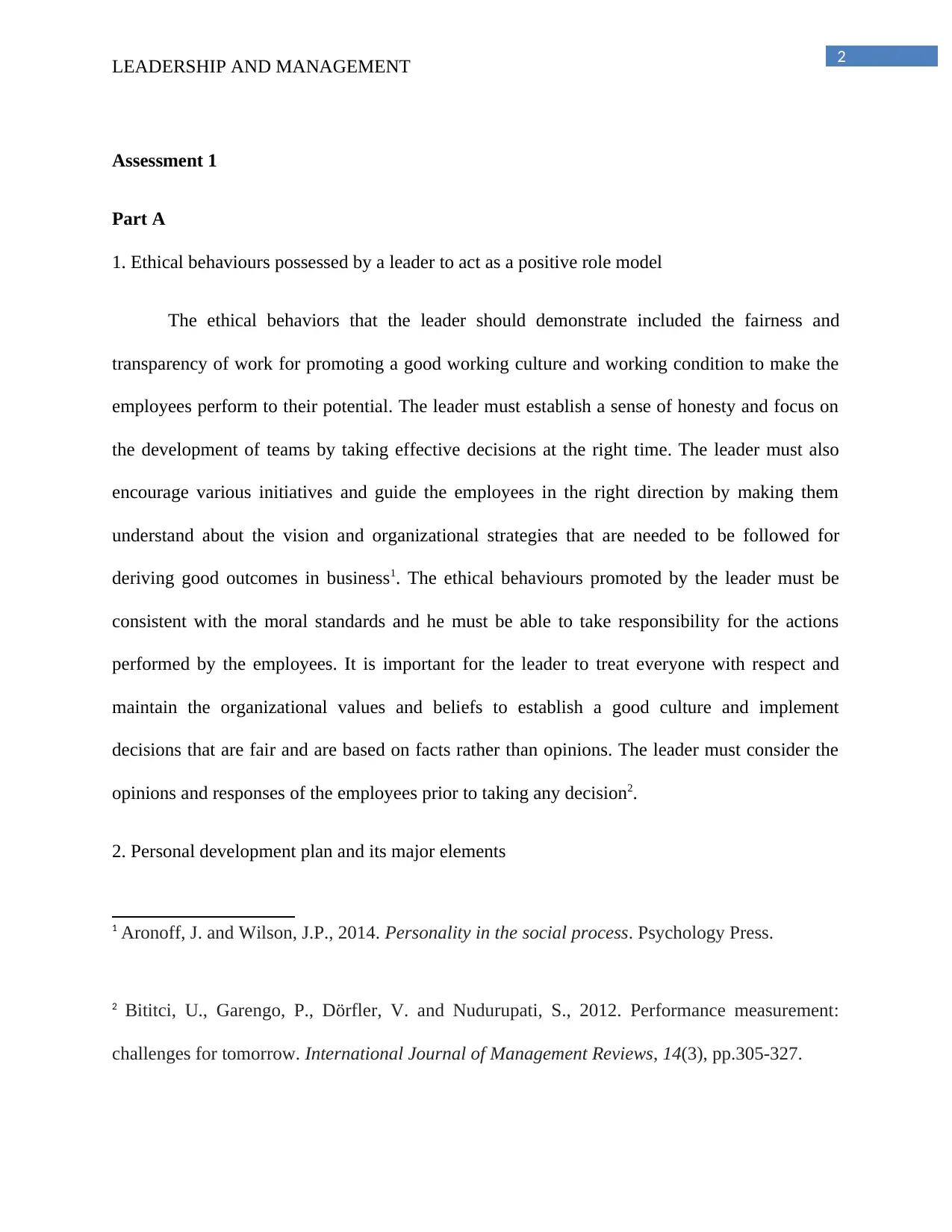
2
LEADERSHIP AND MANAGEMENT
Assessment 1
Part A
1. Ethical behaviours possessed by a leader to act as a positive role model
The ethical behaviors that the leader should demonstrate included the fairness and
transparency of work for promoting a good working culture and working condition to make the
employees perform to their potential. The leader must establish a sense of honesty and focus on
the development of teams by taking effective decisions at the right time. The leader must also
encourage various initiatives and guide the employees in the right direction by making them
understand about the vision and organizational strategies that are needed to be followed for
deriving good outcomes in business1. The ethical behaviours promoted by the leader must be
consistent with the moral standards and he must be able to take responsibility for the actions
performed by the employees. It is important for the leader to treat everyone with respect and
maintain the organizational values and beliefs to establish a good culture and implement
decisions that are fair and are based on facts rather than opinions. The leader must consider the
opinions and responses of the employees prior to taking any decision2.
2. Personal development plan and its major elements
1 Aronoff, J. and Wilson, J.P., 2014. Personality in the social process. Psychology Press.
2 Bititci, U., Garengo, P., Dörfler, V. and Nudurupati, S., 2012. Performance measurement:
challenges for tomorrow. International Journal of Management Reviews, 14(3), pp.305-327.
LEADERSHIP AND MANAGEMENT
Assessment 1
Part A
1. Ethical behaviours possessed by a leader to act as a positive role model
The ethical behaviors that the leader should demonstrate included the fairness and
transparency of work for promoting a good working culture and working condition to make the
employees perform to their potential. The leader must establish a sense of honesty and focus on
the development of teams by taking effective decisions at the right time. The leader must also
encourage various initiatives and guide the employees in the right direction by making them
understand about the vision and organizational strategies that are needed to be followed for
deriving good outcomes in business1. The ethical behaviours promoted by the leader must be
consistent with the moral standards and he must be able to take responsibility for the actions
performed by the employees. It is important for the leader to treat everyone with respect and
maintain the organizational values and beliefs to establish a good culture and implement
decisions that are fair and are based on facts rather than opinions. The leader must consider the
opinions and responses of the employees prior to taking any decision2.
2. Personal development plan and its major elements
1 Aronoff, J. and Wilson, J.P., 2014. Personality in the social process. Psychology Press.
2 Bititci, U., Garengo, P., Dörfler, V. and Nudurupati, S., 2012. Performance measurement:
challenges for tomorrow. International Journal of Management Reviews, 14(3), pp.305-327.
⊘ This is a preview!⊘
Do you want full access?
Subscribe today to unlock all pages.

Trusted by 1+ million students worldwide
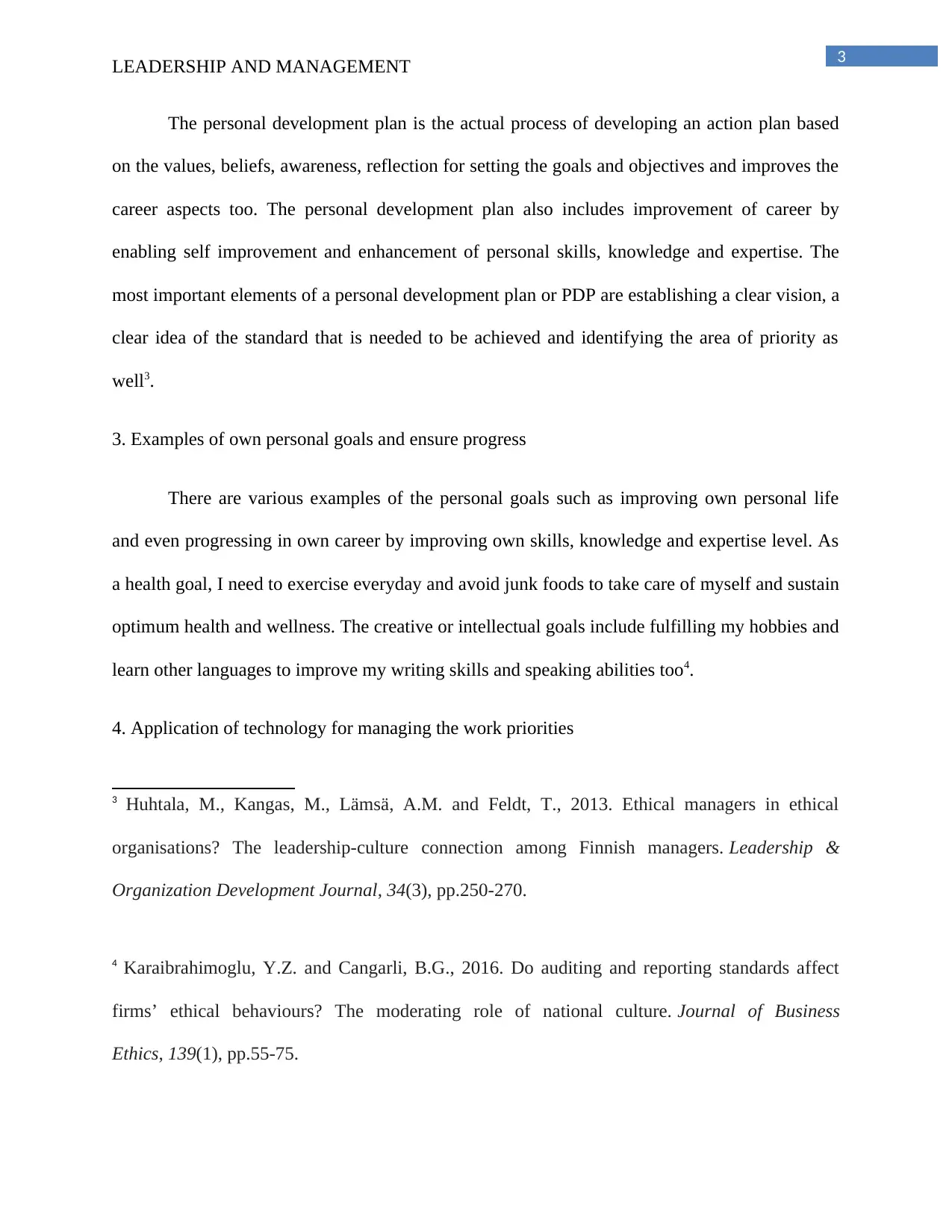
3
LEADERSHIP AND MANAGEMENT
The personal development plan is the actual process of developing an action plan based
on the values, beliefs, awareness, reflection for setting the goals and objectives and improves the
career aspects too. The personal development plan also includes improvement of career by
enabling self improvement and enhancement of personal skills, knowledge and expertise. The
most important elements of a personal development plan or PDP are establishing a clear vision, a
clear idea of the standard that is needed to be achieved and identifying the area of priority as
well3.
3. Examples of own personal goals and ensure progress
There are various examples of the personal goals such as improving own personal life
and even progressing in own career by improving own skills, knowledge and expertise level. As
a health goal, I need to exercise everyday and avoid junk foods to take care of myself and sustain
optimum health and wellness. The creative or intellectual goals include fulfilling my hobbies and
learn other languages to improve my writing skills and speaking abilities too4.
4. Application of technology for managing the work priorities
3 Huhtala, M., Kangas, M., Lämsä, A.M. and Feldt, T., 2013. Ethical managers in ethical
organisations? The leadership-culture connection among Finnish managers. Leadership &
Organization Development Journal, 34(3), pp.250-270.
4 Karaibrahimoglu, Y.Z. and Cangarli, B.G., 2016. Do auditing and reporting standards affect
firms’ ethical behaviours? The moderating role of national culture. Journal of Business
Ethics, 139(1), pp.55-75.
LEADERSHIP AND MANAGEMENT
The personal development plan is the actual process of developing an action plan based
on the values, beliefs, awareness, reflection for setting the goals and objectives and improves the
career aspects too. The personal development plan also includes improvement of career by
enabling self improvement and enhancement of personal skills, knowledge and expertise. The
most important elements of a personal development plan or PDP are establishing a clear vision, a
clear idea of the standard that is needed to be achieved and identifying the area of priority as
well3.
3. Examples of own personal goals and ensure progress
There are various examples of the personal goals such as improving own personal life
and even progressing in own career by improving own skills, knowledge and expertise level. As
a health goal, I need to exercise everyday and avoid junk foods to take care of myself and sustain
optimum health and wellness. The creative or intellectual goals include fulfilling my hobbies and
learn other languages to improve my writing skills and speaking abilities too4.
4. Application of technology for managing the work priorities
3 Huhtala, M., Kangas, M., Lämsä, A.M. and Feldt, T., 2013. Ethical managers in ethical
organisations? The leadership-culture connection among Finnish managers. Leadership &
Organization Development Journal, 34(3), pp.250-270.
4 Karaibrahimoglu, Y.Z. and Cangarli, B.G., 2016. Do auditing and reporting standards affect
firms’ ethical behaviours? The moderating role of national culture. Journal of Business
Ethics, 139(1), pp.55-75.
Paraphrase This Document
Need a fresh take? Get an instant paraphrase of this document with our AI Paraphraser
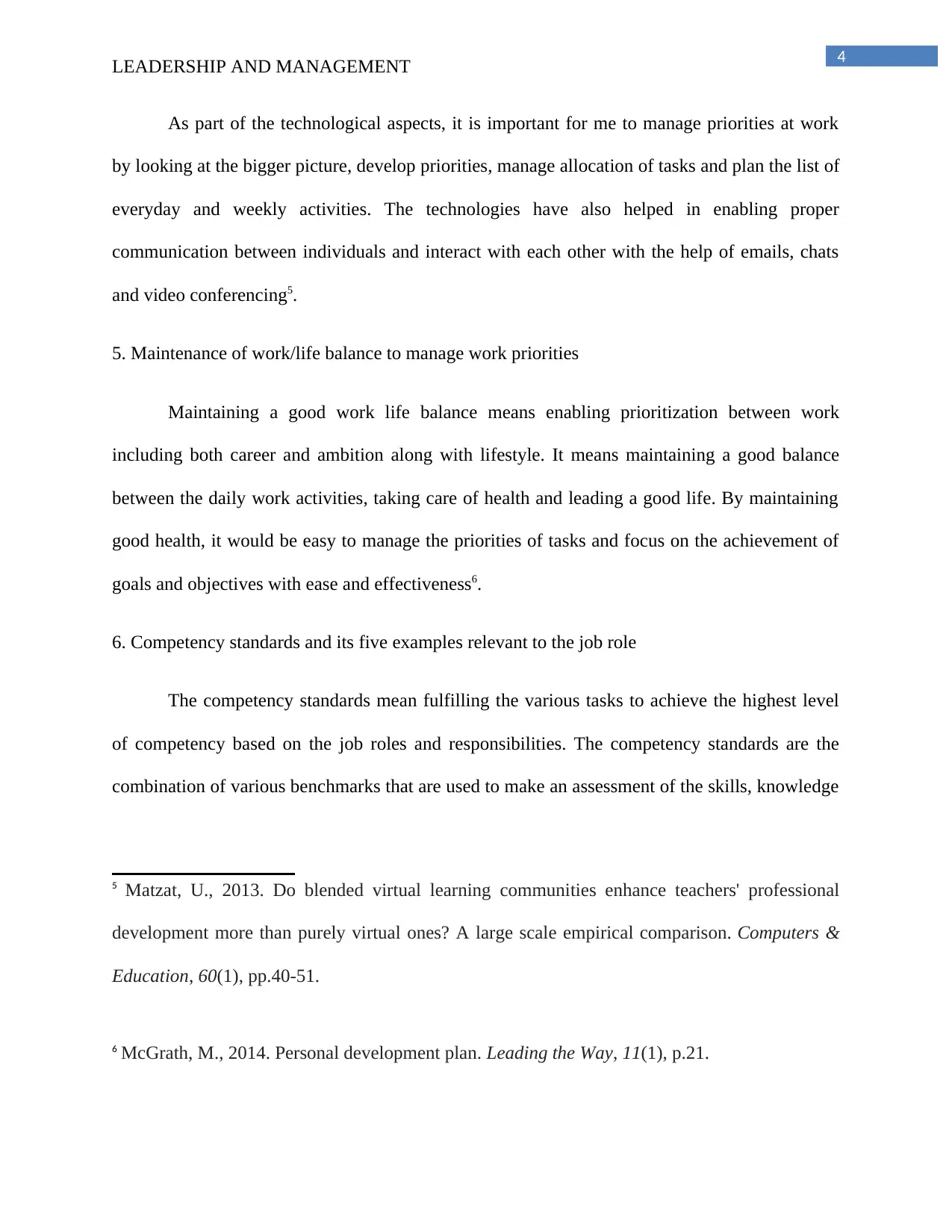
4
LEADERSHIP AND MANAGEMENT
As part of the technological aspects, it is important for me to manage priorities at work
by looking at the bigger picture, develop priorities, manage allocation of tasks and plan the list of
everyday and weekly activities. The technologies have also helped in enabling proper
communication between individuals and interact with each other with the help of emails, chats
and video conferencing5.
5. Maintenance of work/life balance to manage work priorities
Maintaining a good work life balance means enabling prioritization between work
including both career and ambition along with lifestyle. It means maintaining a good balance
between the daily work activities, taking care of health and leading a good life. By maintaining
good health, it would be easy to manage the priorities of tasks and focus on the achievement of
goals and objectives with ease and effectiveness6.
6. Competency standards and its five examples relevant to the job role
The competency standards mean fulfilling the various tasks to achieve the highest level
of competency based on the job roles and responsibilities. The competency standards are the
combination of various benchmarks that are used to make an assessment of the skills, knowledge
5 Matzat, U., 2013. Do blended virtual learning communities enhance teachers' professional
development more than purely virtual ones? A large scale empirical comparison. Computers &
Education, 60(1), pp.40-51.
6 McGrath, M., 2014. Personal development plan. Leading the Way, 11(1), p.21.
LEADERSHIP AND MANAGEMENT
As part of the technological aspects, it is important for me to manage priorities at work
by looking at the bigger picture, develop priorities, manage allocation of tasks and plan the list of
everyday and weekly activities. The technologies have also helped in enabling proper
communication between individuals and interact with each other with the help of emails, chats
and video conferencing5.
5. Maintenance of work/life balance to manage work priorities
Maintaining a good work life balance means enabling prioritization between work
including both career and ambition along with lifestyle. It means maintaining a good balance
between the daily work activities, taking care of health and leading a good life. By maintaining
good health, it would be easy to manage the priorities of tasks and focus on the achievement of
goals and objectives with ease and effectiveness6.
6. Competency standards and its five examples relevant to the job role
The competency standards mean fulfilling the various tasks to achieve the highest level
of competency based on the job roles and responsibilities. The competency standards are the
combination of various benchmarks that are used to make an assessment of the skills, knowledge
5 Matzat, U., 2013. Do blended virtual learning communities enhance teachers' professional
development more than purely virtual ones? A large scale empirical comparison. Computers &
Education, 60(1), pp.40-51.
6 McGrath, M., 2014. Personal development plan. Leading the Way, 11(1), p.21.
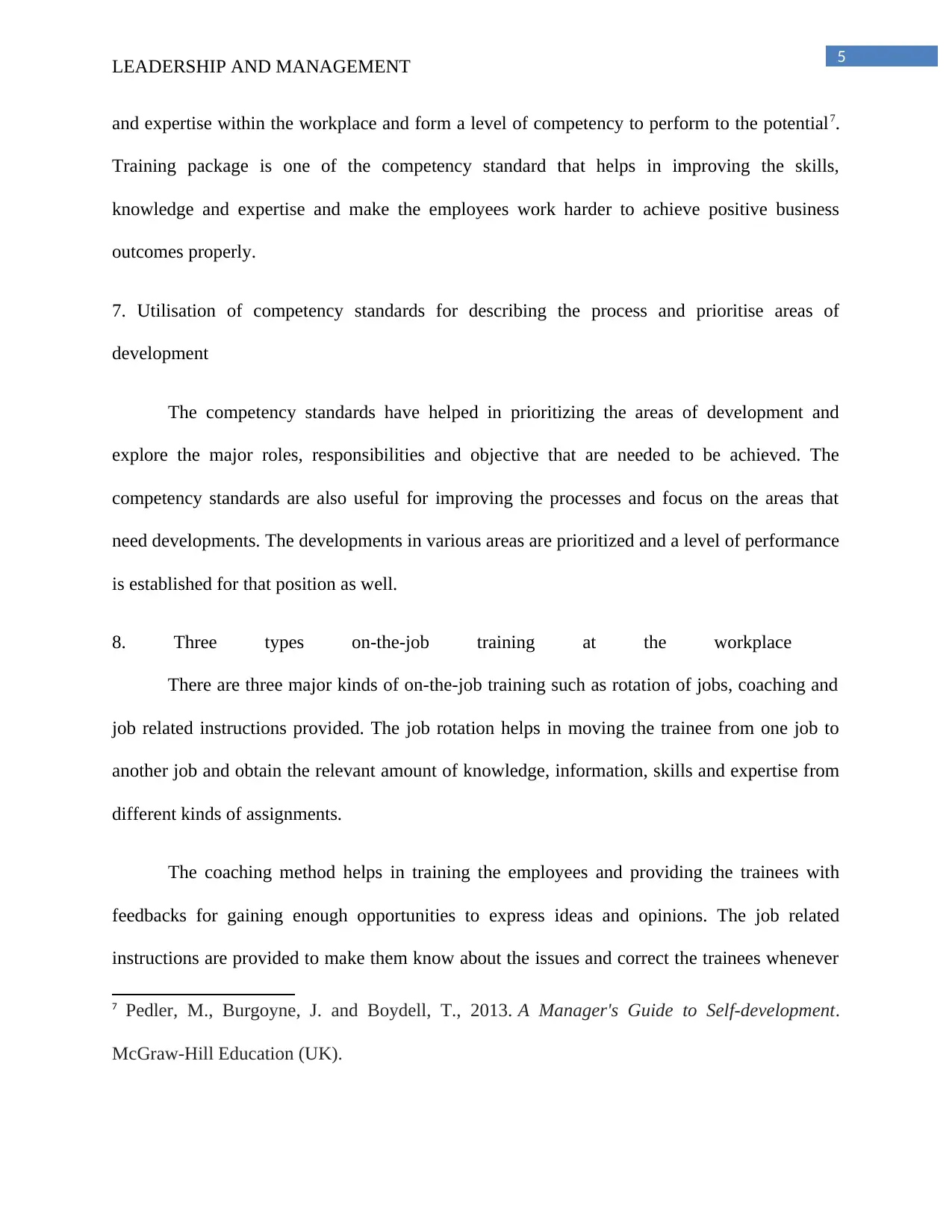
5
LEADERSHIP AND MANAGEMENT
and expertise within the workplace and form a level of competency to perform to the potential7.
Training package is one of the competency standard that helps in improving the skills,
knowledge and expertise and make the employees work harder to achieve positive business
outcomes properly.
7. Utilisation of competency standards for describing the process and prioritise areas of
development
The competency standards have helped in prioritizing the areas of development and
explore the major roles, responsibilities and objective that are needed to be achieved. The
competency standards are also useful for improving the processes and focus on the areas that
need developments. The developments in various areas are prioritized and a level of performance
is established for that position as well.
8. Three types on-the-job training at the workplace
There are three major kinds of on-the-job training such as rotation of jobs, coaching and
job related instructions provided. The job rotation helps in moving the trainee from one job to
another job and obtain the relevant amount of knowledge, information, skills and expertise from
different kinds of assignments.
The coaching method helps in training the employees and providing the trainees with
feedbacks for gaining enough opportunities to express ideas and opinions. The job related
instructions are provided to make them know about the issues and correct the trainees whenever
7 Pedler, M., Burgoyne, J. and Boydell, T., 2013. A Manager's Guide to Self-development.
McGraw-Hill Education (UK).
LEADERSHIP AND MANAGEMENT
and expertise within the workplace and form a level of competency to perform to the potential7.
Training package is one of the competency standard that helps in improving the skills,
knowledge and expertise and make the employees work harder to achieve positive business
outcomes properly.
7. Utilisation of competency standards for describing the process and prioritise areas of
development
The competency standards have helped in prioritizing the areas of development and
explore the major roles, responsibilities and objective that are needed to be achieved. The
competency standards are also useful for improving the processes and focus on the areas that
need developments. The developments in various areas are prioritized and a level of performance
is established for that position as well.
8. Three types on-the-job training at the workplace
There are three major kinds of on-the-job training such as rotation of jobs, coaching and
job related instructions provided. The job rotation helps in moving the trainee from one job to
another job and obtain the relevant amount of knowledge, information, skills and expertise from
different kinds of assignments.
The coaching method helps in training the employees and providing the trainees with
feedbacks for gaining enough opportunities to express ideas and opinions. The job related
instructions are provided to make them know about the issues and correct the trainees whenever
7 Pedler, M., Burgoyne, J. and Boydell, T., 2013. A Manager's Guide to Self-development.
McGraw-Hill Education (UK).
⊘ This is a preview!⊘
Do you want full access?
Subscribe today to unlock all pages.

Trusted by 1+ million students worldwide
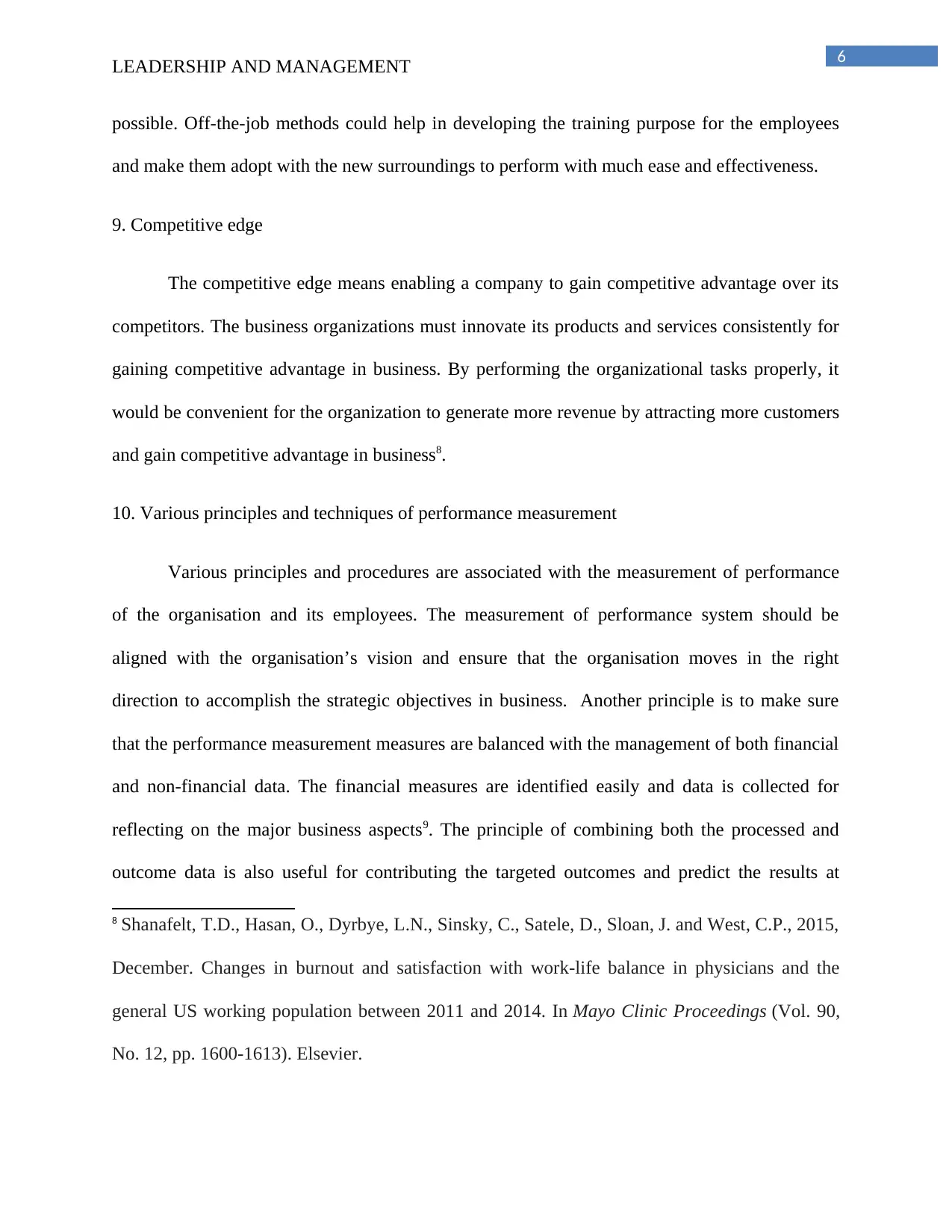
6
LEADERSHIP AND MANAGEMENT
possible. Off-the-job methods could help in developing the training purpose for the employees
and make them adopt with the new surroundings to perform with much ease and effectiveness.
9. Competitive edge
The competitive edge means enabling a company to gain competitive advantage over its
competitors. The business organizations must innovate its products and services consistently for
gaining competitive advantage in business. By performing the organizational tasks properly, it
would be convenient for the organization to generate more revenue by attracting more customers
and gain competitive advantage in business8.
10. Various principles and techniques of performance measurement
Various principles and procedures are associated with the measurement of performance
of the organisation and its employees. The measurement of performance system should be
aligned with the organisation’s vision and ensure that the organisation moves in the right
direction to accomplish the strategic objectives in business. Another principle is to make sure
that the performance measurement measures are balanced with the management of both financial
and non-financial data. The financial measures are identified easily and data is collected for
reflecting on the major business aspects9. The principle of combining both the processed and
outcome data is also useful for contributing the targeted outcomes and predict the results at
8 Shanafelt, T.D., Hasan, O., Dyrbye, L.N., Sinsky, C., Satele, D., Sloan, J. and West, C.P., 2015,
December. Changes in burnout and satisfaction with work-life balance in physicians and the
general US working population between 2011 and 2014. In Mayo Clinic Proceedings (Vol. 90,
No. 12, pp. 1600-1613). Elsevier.
LEADERSHIP AND MANAGEMENT
possible. Off-the-job methods could help in developing the training purpose for the employees
and make them adopt with the new surroundings to perform with much ease and effectiveness.
9. Competitive edge
The competitive edge means enabling a company to gain competitive advantage over its
competitors. The business organizations must innovate its products and services consistently for
gaining competitive advantage in business. By performing the organizational tasks properly, it
would be convenient for the organization to generate more revenue by attracting more customers
and gain competitive advantage in business8.
10. Various principles and techniques of performance measurement
Various principles and procedures are associated with the measurement of performance
of the organisation and its employees. The measurement of performance system should be
aligned with the organisation’s vision and ensure that the organisation moves in the right
direction to accomplish the strategic objectives in business. Another principle is to make sure
that the performance measurement measures are balanced with the management of both financial
and non-financial data. The financial measures are identified easily and data is collected for
reflecting on the major business aspects9. The principle of combining both the processed and
outcome data is also useful for contributing the targeted outcomes and predict the results at
8 Shanafelt, T.D., Hasan, O., Dyrbye, L.N., Sinsky, C., Satele, D., Sloan, J. and West, C.P., 2015,
December. Changes in burnout and satisfaction with work-life balance in physicians and the
general US working population between 2011 and 2014. In Mayo Clinic Proceedings (Vol. 90,
No. 12, pp. 1600-1613). Elsevier.
Paraphrase This Document
Need a fresh take? Get an instant paraphrase of this document with our AI Paraphraser
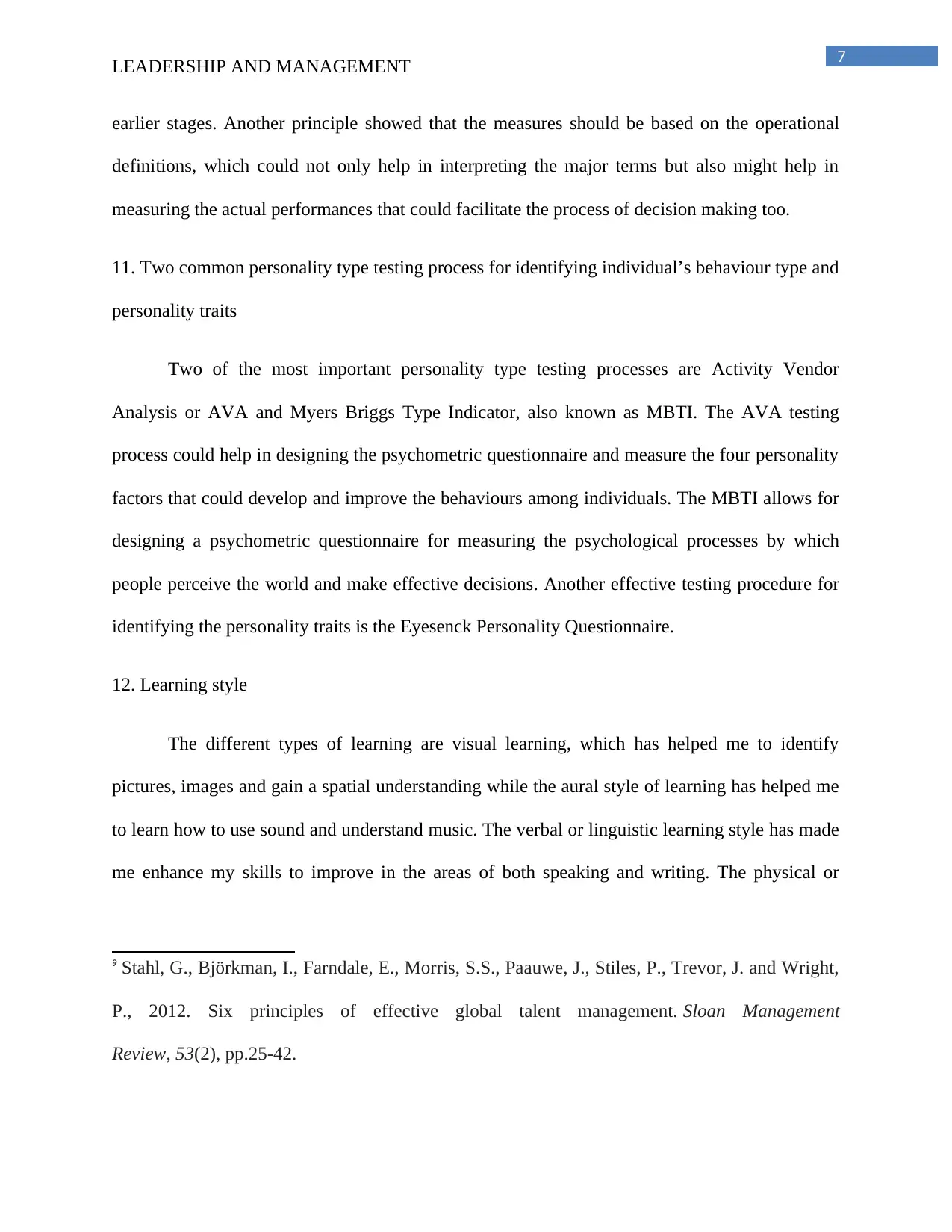
7
LEADERSHIP AND MANAGEMENT
earlier stages. Another principle showed that the measures should be based on the operational
definitions, which could not only help in interpreting the major terms but also might help in
measuring the actual performances that could facilitate the process of decision making too.
11. Two common personality type testing process for identifying individual’s behaviour type and
personality traits
Two of the most important personality type testing processes are Activity Vendor
Analysis or AVA and Myers Briggs Type Indicator, also known as MBTI. The AVA testing
process could help in designing the psychometric questionnaire and measure the four personality
factors that could develop and improve the behaviours among individuals. The MBTI allows for
designing a psychometric questionnaire for measuring the psychological processes by which
people perceive the world and make effective decisions. Another effective testing procedure for
identifying the personality traits is the Eyesenck Personality Questionnaire.
12. Learning style
The different types of learning are visual learning, which has helped me to identify
pictures, images and gain a spatial understanding while the aural style of learning has helped me
to learn how to use sound and understand music. The verbal or linguistic learning style has made
me enhance my skills to improve in the areas of both speaking and writing. The physical or
9 Stahl, G., Björkman, I., Farndale, E., Morris, S.S., Paauwe, J., Stiles, P., Trevor, J. and Wright,
P., 2012. Six principles of effective global talent management. Sloan Management
Review, 53(2), pp.25-42.
LEADERSHIP AND MANAGEMENT
earlier stages. Another principle showed that the measures should be based on the operational
definitions, which could not only help in interpreting the major terms but also might help in
measuring the actual performances that could facilitate the process of decision making too.
11. Two common personality type testing process for identifying individual’s behaviour type and
personality traits
Two of the most important personality type testing processes are Activity Vendor
Analysis or AVA and Myers Briggs Type Indicator, also known as MBTI. The AVA testing
process could help in designing the psychometric questionnaire and measure the four personality
factors that could develop and improve the behaviours among individuals. The MBTI allows for
designing a psychometric questionnaire for measuring the psychological processes by which
people perceive the world and make effective decisions. Another effective testing procedure for
identifying the personality traits is the Eyesenck Personality Questionnaire.
12. Learning style
The different types of learning are visual learning, which has helped me to identify
pictures, images and gain a spatial understanding while the aural style of learning has helped me
to learn how to use sound and understand music. The verbal or linguistic learning style has made
me enhance my skills to improve in the areas of both speaking and writing. The physical or
9 Stahl, G., Björkman, I., Farndale, E., Morris, S.S., Paauwe, J., Stiles, P., Trevor, J. and Wright,
P., 2012. Six principles of effective global talent management. Sloan Management
Review, 53(2), pp.25-42.
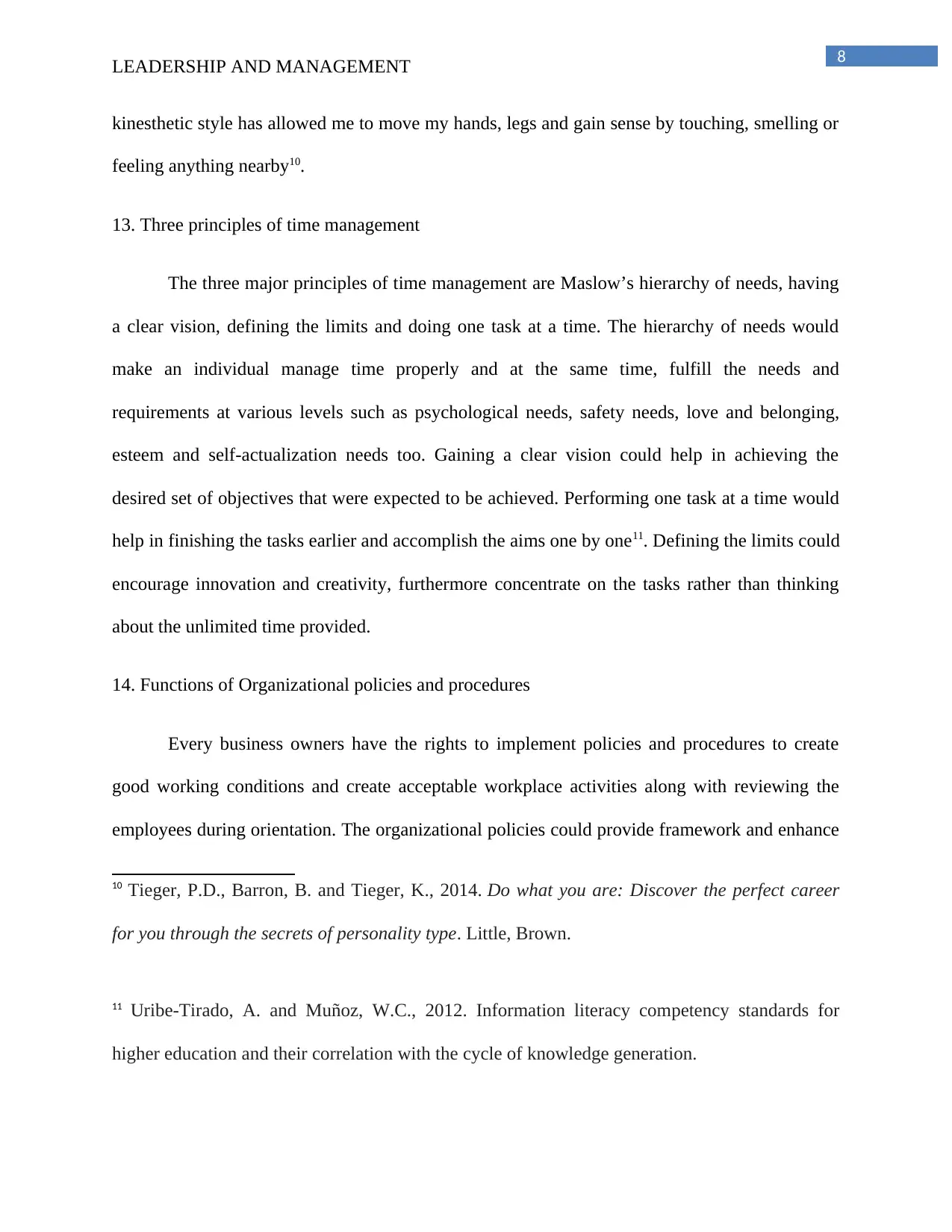
8
LEADERSHIP AND MANAGEMENT
kinesthetic style has allowed me to move my hands, legs and gain sense by touching, smelling or
feeling anything nearby10.
13. Three principles of time management
The three major principles of time management are Maslow’s hierarchy of needs, having
a clear vision, defining the limits and doing one task at a time. The hierarchy of needs would
make an individual manage time properly and at the same time, fulfill the needs and
requirements at various levels such as psychological needs, safety needs, love and belonging,
esteem and self-actualization needs too. Gaining a clear vision could help in achieving the
desired set of objectives that were expected to be achieved. Performing one task at a time would
help in finishing the tasks earlier and accomplish the aims one by one11. Defining the limits could
encourage innovation and creativity, furthermore concentrate on the tasks rather than thinking
about the unlimited time provided.
14. Functions of Organizational policies and procedures
Every business owners have the rights to implement policies and procedures to create
good working conditions and create acceptable workplace activities along with reviewing the
employees during orientation. The organizational policies could provide framework and enhance
10 Tieger, P.D., Barron, B. and Tieger, K., 2014. Do what you are: Discover the perfect career
for you through the secrets of personality type. Little, Brown.
11 Uribe-Tirado, A. and Muñoz, W.C., 2012. Information literacy competency standards for
higher education and their correlation with the cycle of knowledge generation.
LEADERSHIP AND MANAGEMENT
kinesthetic style has allowed me to move my hands, legs and gain sense by touching, smelling or
feeling anything nearby10.
13. Three principles of time management
The three major principles of time management are Maslow’s hierarchy of needs, having
a clear vision, defining the limits and doing one task at a time. The hierarchy of needs would
make an individual manage time properly and at the same time, fulfill the needs and
requirements at various levels such as psychological needs, safety needs, love and belonging,
esteem and self-actualization needs too. Gaining a clear vision could help in achieving the
desired set of objectives that were expected to be achieved. Performing one task at a time would
help in finishing the tasks earlier and accomplish the aims one by one11. Defining the limits could
encourage innovation and creativity, furthermore concentrate on the tasks rather than thinking
about the unlimited time provided.
14. Functions of Organizational policies and procedures
Every business owners have the rights to implement policies and procedures to create
good working conditions and create acceptable workplace activities along with reviewing the
employees during orientation. The organizational policies could provide framework and enhance
10 Tieger, P.D., Barron, B. and Tieger, K., 2014. Do what you are: Discover the perfect career
for you through the secrets of personality type. Little, Brown.
11 Uribe-Tirado, A. and Muñoz, W.C., 2012. Information literacy competency standards for
higher education and their correlation with the cycle of knowledge generation.
⊘ This is a preview!⊘
Do you want full access?
Subscribe today to unlock all pages.

Trusted by 1+ million students worldwide
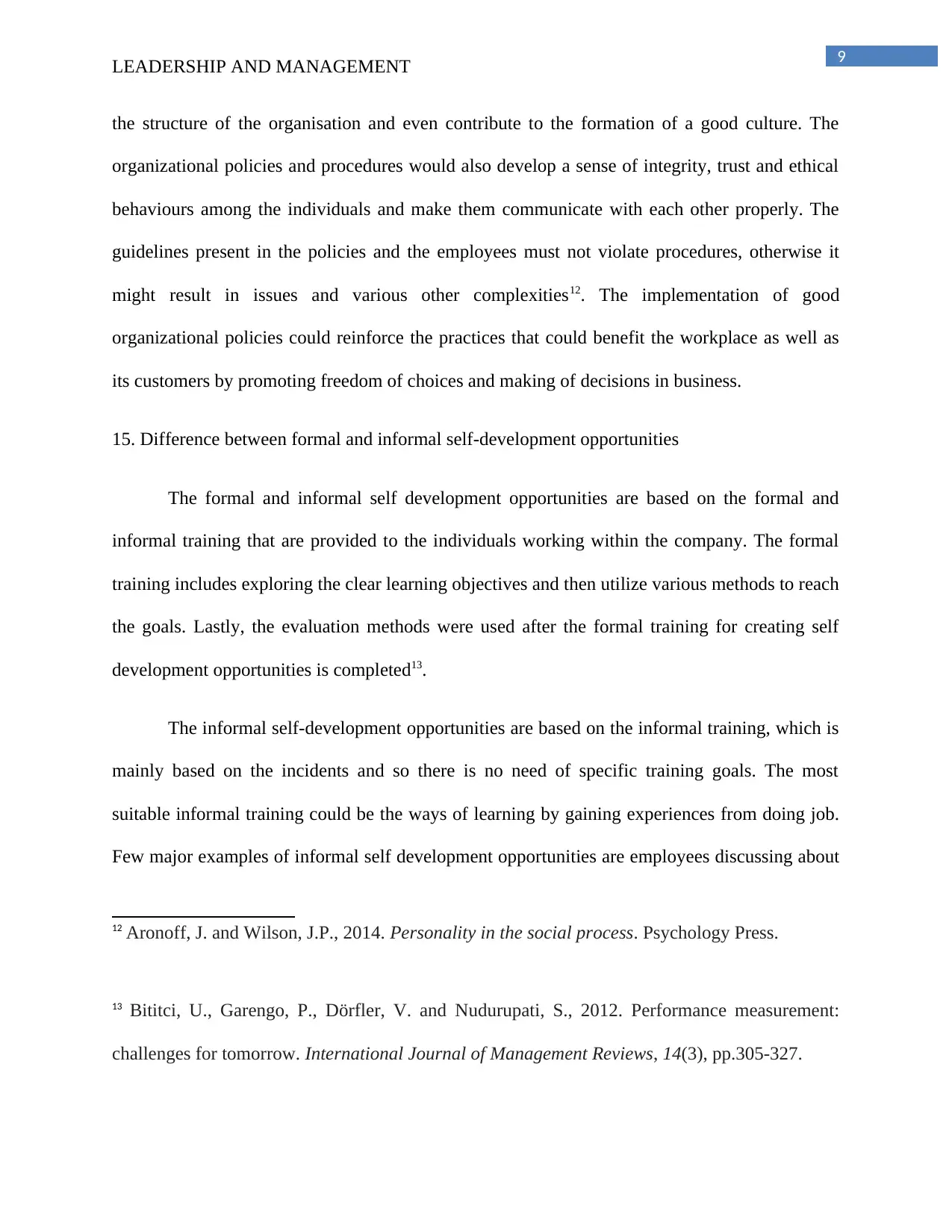
9
LEADERSHIP AND MANAGEMENT
the structure of the organisation and even contribute to the formation of a good culture. The
organizational policies and procedures would also develop a sense of integrity, trust and ethical
behaviours among the individuals and make them communicate with each other properly. The
guidelines present in the policies and the employees must not violate procedures, otherwise it
might result in issues and various other complexities12. The implementation of good
organizational policies could reinforce the practices that could benefit the workplace as well as
its customers by promoting freedom of choices and making of decisions in business.
15. Difference between formal and informal self-development opportunities
The formal and informal self development opportunities are based on the formal and
informal training that are provided to the individuals working within the company. The formal
training includes exploring the clear learning objectives and then utilize various methods to reach
the goals. Lastly, the evaluation methods were used after the formal training for creating self
development opportunities is completed13.
The informal self-development opportunities are based on the informal training, which is
mainly based on the incidents and so there is no need of specific training goals. The most
suitable informal training could be the ways of learning by gaining experiences from doing job.
Few major examples of informal self development opportunities are employees discussing about
12 Aronoff, J. and Wilson, J.P., 2014. Personality in the social process. Psychology Press.
13 Bititci, U., Garengo, P., Dörfler, V. and Nudurupati, S., 2012. Performance measurement:
challenges for tomorrow. International Journal of Management Reviews, 14(3), pp.305-327.
LEADERSHIP AND MANAGEMENT
the structure of the organisation and even contribute to the formation of a good culture. The
organizational policies and procedures would also develop a sense of integrity, trust and ethical
behaviours among the individuals and make them communicate with each other properly. The
guidelines present in the policies and the employees must not violate procedures, otherwise it
might result in issues and various other complexities12. The implementation of good
organizational policies could reinforce the practices that could benefit the workplace as well as
its customers by promoting freedom of choices and making of decisions in business.
15. Difference between formal and informal self-development opportunities
The formal and informal self development opportunities are based on the formal and
informal training that are provided to the individuals working within the company. The formal
training includes exploring the clear learning objectives and then utilize various methods to reach
the goals. Lastly, the evaluation methods were used after the formal training for creating self
development opportunities is completed13.
The informal self-development opportunities are based on the informal training, which is
mainly based on the incidents and so there is no need of specific training goals. The most
suitable informal training could be the ways of learning by gaining experiences from doing job.
Few major examples of informal self development opportunities are employees discussing about
12 Aronoff, J. and Wilson, J.P., 2014. Personality in the social process. Psychology Press.
13 Bititci, U., Garengo, P., Dörfler, V. and Nudurupati, S., 2012. Performance measurement:
challenges for tomorrow. International Journal of Management Reviews, 14(3), pp.305-327.
Paraphrase This Document
Need a fresh take? Get an instant paraphrase of this document with our AI Paraphraser
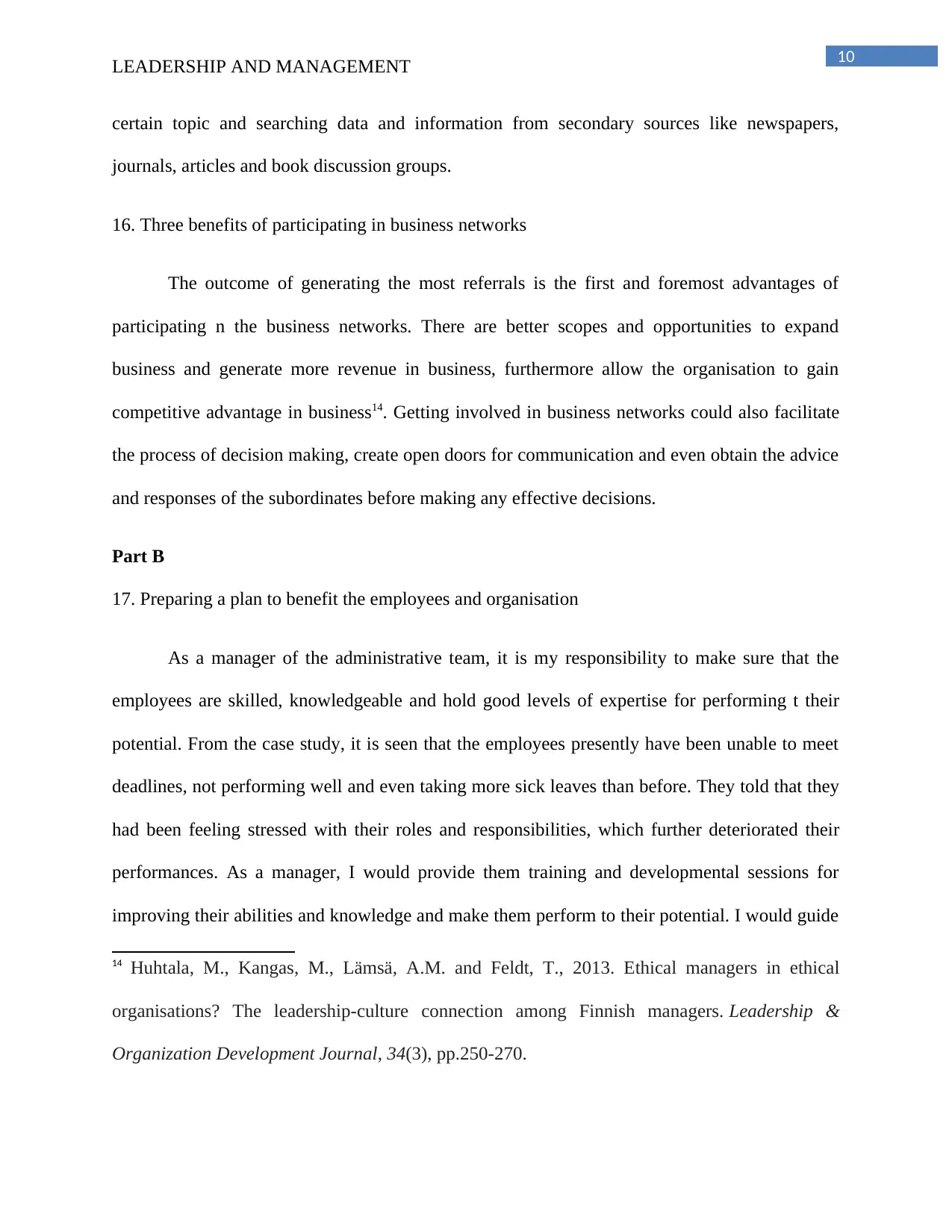
10
LEADERSHIP AND MANAGEMENT
certain topic and searching data and information from secondary sources like newspapers,
journals, articles and book discussion groups.
16. Three benefits of participating in business networks
The outcome of generating the most referrals is the first and foremost advantages of
participating n the business networks. There are better scopes and opportunities to expand
business and generate more revenue in business, furthermore allow the organisation to gain
competitive advantage in business14. Getting involved in business networks could also facilitate
the process of decision making, create open doors for communication and even obtain the advice
and responses of the subordinates before making any effective decisions.
Part B
17. Preparing a plan to benefit the employees and organisation
As a manager of the administrative team, it is my responsibility to make sure that the
employees are skilled, knowledgeable and hold good levels of expertise for performing t their
potential. From the case study, it is seen that the employees presently have been unable to meet
deadlines, not performing well and even taking more sick leaves than before. They told that they
had been feeling stressed with their roles and responsibilities, which further deteriorated their
performances. As a manager, I would provide them training and developmental sessions for
improving their abilities and knowledge and make them perform to their potential. I would guide
14 Huhtala, M., Kangas, M., Lämsä, A.M. and Feldt, T., 2013. Ethical managers in ethical
organisations? The leadership-culture connection among Finnish managers. Leadership &
Organization Development Journal, 34(3), pp.250-270.
LEADERSHIP AND MANAGEMENT
certain topic and searching data and information from secondary sources like newspapers,
journals, articles and book discussion groups.
16. Three benefits of participating in business networks
The outcome of generating the most referrals is the first and foremost advantages of
participating n the business networks. There are better scopes and opportunities to expand
business and generate more revenue in business, furthermore allow the organisation to gain
competitive advantage in business14. Getting involved in business networks could also facilitate
the process of decision making, create open doors for communication and even obtain the advice
and responses of the subordinates before making any effective decisions.
Part B
17. Preparing a plan to benefit the employees and organisation
As a manager of the administrative team, it is my responsibility to make sure that the
employees are skilled, knowledgeable and hold good levels of expertise for performing t their
potential. From the case study, it is seen that the employees presently have been unable to meet
deadlines, not performing well and even taking more sick leaves than before. They told that they
had been feeling stressed with their roles and responsibilities, which further deteriorated their
performances. As a manager, I would provide them training and developmental sessions for
improving their abilities and knowledge and make them perform to their potential. I would guide
14 Huhtala, M., Kangas, M., Lämsä, A.M. and Feldt, T., 2013. Ethical managers in ethical
organisations? The leadership-culture connection among Finnish managers. Leadership &
Organization Development Journal, 34(3), pp.250-270.
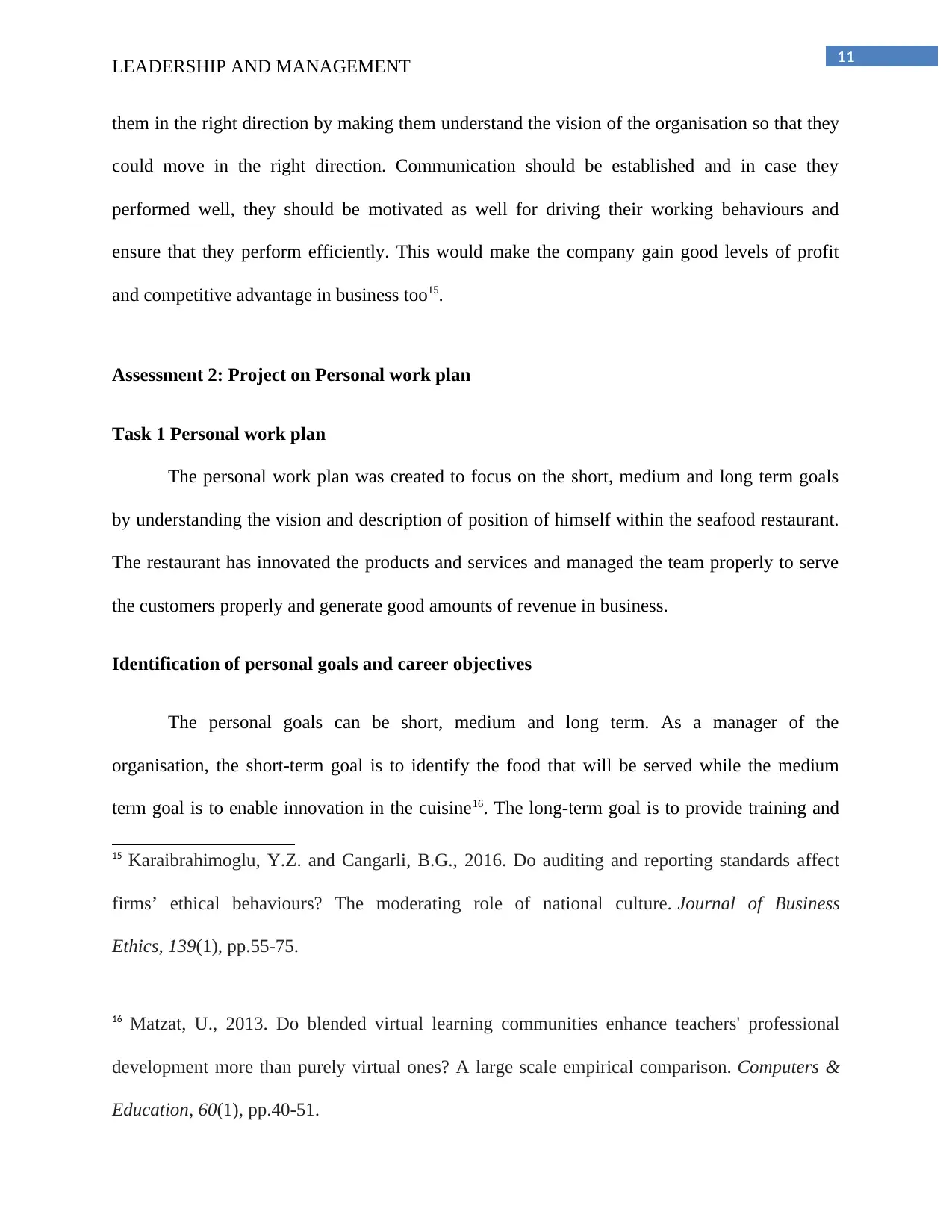
11
LEADERSHIP AND MANAGEMENT
them in the right direction by making them understand the vision of the organisation so that they
could move in the right direction. Communication should be established and in case they
performed well, they should be motivated as well for driving their working behaviours and
ensure that they perform efficiently. This would make the company gain good levels of profit
and competitive advantage in business too15.
Assessment 2: Project on Personal work plan
Task 1 Personal work plan
The personal work plan was created to focus on the short, medium and long term goals
by understanding the vision and description of position of himself within the seafood restaurant.
The restaurant has innovated the products and services and managed the team properly to serve
the customers properly and generate good amounts of revenue in business.
Identification of personal goals and career objectives
The personal goals can be short, medium and long term. As a manager of the
organisation, the short-term goal is to identify the food that will be served while the medium
term goal is to enable innovation in the cuisine16. The long-term goal is to provide training and
15 Karaibrahimoglu, Y.Z. and Cangarli, B.G., 2016. Do auditing and reporting standards affect
firms’ ethical behaviours? The moderating role of national culture. Journal of Business
Ethics, 139(1), pp.55-75.
16 Matzat, U., 2013. Do blended virtual learning communities enhance teachers' professional
development more than purely virtual ones? A large scale empirical comparison. Computers &
Education, 60(1), pp.40-51.
LEADERSHIP AND MANAGEMENT
them in the right direction by making them understand the vision of the organisation so that they
could move in the right direction. Communication should be established and in case they
performed well, they should be motivated as well for driving their working behaviours and
ensure that they perform efficiently. This would make the company gain good levels of profit
and competitive advantage in business too15.
Assessment 2: Project on Personal work plan
Task 1 Personal work plan
The personal work plan was created to focus on the short, medium and long term goals
by understanding the vision and description of position of himself within the seafood restaurant.
The restaurant has innovated the products and services and managed the team properly to serve
the customers properly and generate good amounts of revenue in business.
Identification of personal goals and career objectives
The personal goals can be short, medium and long term. As a manager of the
organisation, the short-term goal is to identify the food that will be served while the medium
term goal is to enable innovation in the cuisine16. The long-term goal is to provide training and
15 Karaibrahimoglu, Y.Z. and Cangarli, B.G., 2016. Do auditing and reporting standards affect
firms’ ethical behaviours? The moderating role of national culture. Journal of Business
Ethics, 139(1), pp.55-75.
16 Matzat, U., 2013. Do blended virtual learning communities enhance teachers' professional
development more than purely virtual ones? A large scale empirical comparison. Computers &
Education, 60(1), pp.40-51.
⊘ This is a preview!⊘
Do you want full access?
Subscribe today to unlock all pages.

Trusted by 1+ million students worldwide
1 out of 20
Related Documents
Your All-in-One AI-Powered Toolkit for Academic Success.
+13062052269
info@desklib.com
Available 24*7 on WhatsApp / Email
![[object Object]](/_next/static/media/star-bottom.7253800d.svg)
Unlock your academic potential
Copyright © 2020–2025 A2Z Services. All Rights Reserved. Developed and managed by ZUCOL.


![[University] Leadership and Management Reflective Essay - [Module]](/_next/image/?url=https%3A%2F%2Fdesklib.com%2Fmedia%2Fimages%2Ffg%2Fc92cbcc5f4dc48e2a67d941cd8fa027d.jpg&w=256&q=75)

